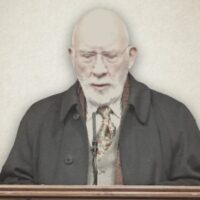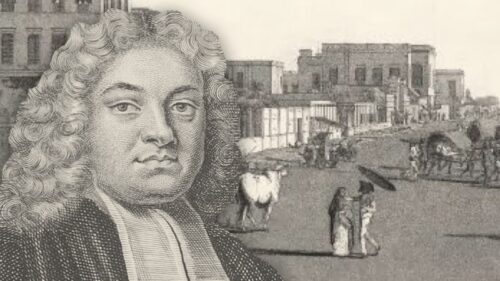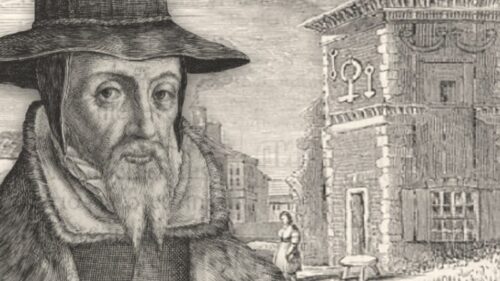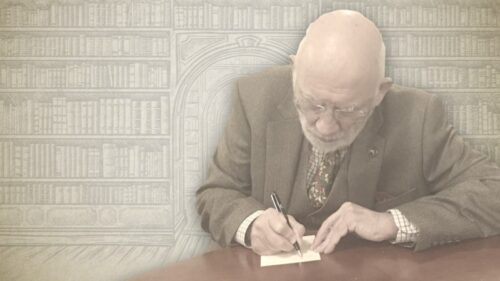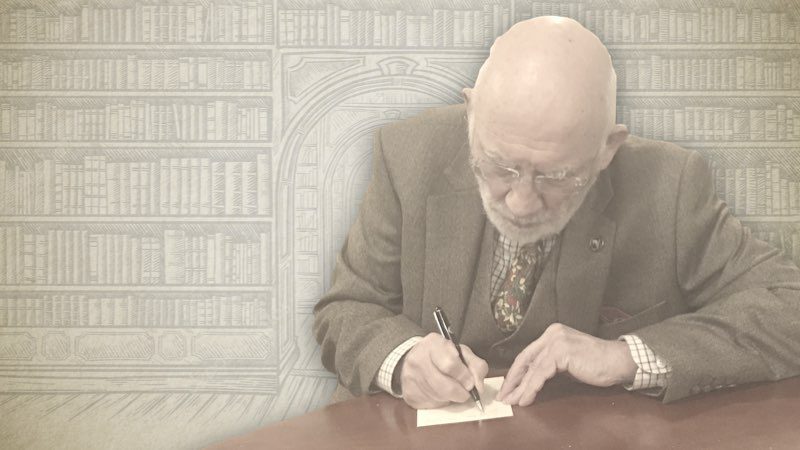
Carl Olof Rosenius: And The Great Swedish Awakening
[Posted With Permission, Peter Meney Of “New Focus“]
My introduction to Rosenius
In the summer of 1960, I found myself in Northern Sweden helping Frans-Oscar Linde, a missionary to the Lapps. I was under great apprehension because I had recently sat for the London University Advanced Level General Certificates of Education with a view to continuing my course at London Bible College and matriculating for a London University BD degree. Two events put me at ease. First, a friendly pastor gave me a book called Korta dagbetraktelser by Carl Olof Rosenius. It was a collection of exquisite spiritual gems of daily readings throughout the year. After my conversion in Sweden, I had studied dry, Liberal works on the Bible and Church History in preparation for my A level in ‘Religious Knowledge’ so it was a real delight to read edifying words of comfort and strength from the pen of a man who had always practised what he preached. Rosenius showed me why Christian living was more than mere ‘notion’ and was deeply empirical and experiential. The next event was that I had arranged for the A level results to be sent out to a post office in Jämtland. The document duly arrived and I opened it surrounded by praying friends. The A level examiners had kindly given me the required success.
A precocious little snob
In 1816 Carl Olof Rosenius was born to curate Anders Rosenius of Pitea, and Sara Margareta née Norenius, of Arjeplog. At the time, Anders was serving in Nysätra in the county of Västerbotten to the west of the great bay which divides Finland from Sweden. It was the time when the first signs of revival were spreading throughout northern Scandinavia, chiefly through the work of Anders who was a great evangelist and soul-winner. He transformed his first parish in Stöde into a true church by organising circles of so-called ‘readers’ (läsare) in the farmsteads and kotas (dwellings of the Same or Lapps) far outside of the parish. The church authorities found this too ‘irregular’, so, to discipline him, they gave Anders temporary work here and there, hoping he would not have much opportunity and time for ‘irregularities’. The result was that Carl’s childhood was truly nomadic as Anders was sent at short intervals from Pitea to Älvsbyn, Ranea, Nysätra, Säfvar, Kalix and other places throughout the North. Wherever Anders Rosenius went, revival broke out. Tired of ‘disciplining’ Anders, the bishop gave him the parish of Burträsk in 1834 where he performed the duties of a pastor and evangelist under great blessings until his death in 1841.
Carl was the third child amongst seven and he resolved to walk in his father’s footsteps from his earliest years. However, he began to give himself airs as if he were the holiest of little boys. Once for instance, when his older brother disagreed with him, Carl scolded him with the words, ‘He who does not believe shall be damned’. Another time, young Carl tempted God by blindfolding himself in dangerous territory, telling himself that God would keep him from danger. Suddenly, he became fearful and tore the scarf from his eyes. He was standing on the brink of a large, deep well. He escaped accidents on several occasions by similar ‘tests’. This made Carl believe that he stood in special favour with God and was in a position to admonish others, especially his older brother Anton with whom he was sent off to boarding-school. Anton was a good artist and began to sell his paintings. Anton’s father told him never to demand more than a crown a picture but his customers paid more. Carl told his brother that he could not be blessed by God as he not only disobeyed his father but also God’s fourth commandment.
A humble change takes place
At the age of 15, I-am-holier-than-thou Carl at last began to realise that he was a sinner and his conscience plagued him. Whenever he returned home, his father sought to discuss Carl’s conviction of sin with him and point out Christ’s willingness to forgive such a sinner. One day in the 1830 school holidays, Carl came down to breakfast to find a book awaiting him on the table. It was by Erik Pontoppidan the famous Norwegian bishop-evangelist, called The Bright Mirror of Faith which Carl immediately started to read. Pontoppidan outlined eight ways of testing a person’s faith. Rosenius read through seven of the ways, patting himself on the shoulder all the time as they described his own external faith exactly. Then he received a shock. The good bishop explained that the eighth way must be read most carefully as one could tick off the previous seven ways and imagine that one was going to heaven but such self-righteous ways led to hell. Carl read on as Pontoppidan outlined the Biblical teaching of the New Birth. He was gripped by an enormous conviction of sin which held him for several days, but gradually he became aware of God’s tender mercies and patience towards him. Shortly afterwards, Carl was walking through the woods when renewed conviction came upon him and he bent his knees in prayer which only ended when he had found Christ as his personal Saviour.
The young evangelist
Carl immediately began evangelising his friends and schoolmates who gave him the name of ‘Little Reformer’ or ‘Luther The Second’ as he was always found reading the Bible and Luther’s works. Though only fifteen, Rosenius began to attend a local Reader group with Anton and was soon asked to lead it. This angered a number of Carl’s classmates who pelted the windows with mud whenever Carl spoke. In 1833, Rosenius and Anton were sent to the Grammar School at Härnösand, 250 kilometres from their home. Immediately, Rosenius founded a Readers’ Society in his new school but few pupils joined him. The teachers and local clergy protested strongly against this move but Carl appealed to the bishop who advised him to stop his mid-week work but promised him he would arrange for a weekly service to be held at the school run by a minister. Carl and his friends were allowed to meet on Sunday evenings when the school had no jurisdiction over them.
At the age of 18, Rosenius found a new ministry in letter-writing. Because of his nomad-like existence, he had contacted many people who were without a local witness. These began to look to Rosenius for spiritual guidance which they found in his letters dealing with the trials and conflicts of the Christian life and the work and witness of Christ in overcoming them. Rosenius’ education, however, was too expensive for his father so Rosenius worked as a house-teacher in his spare time to pay his way. His letters from this period show how different he had become from the Carl Rosenius of the cocksure days of his childhood. Now his own sins and failings often grieved him and he longed to be more like his Lord. In the Spring of 1837, Rosenius passed his university entrance exams with top marks and returned home to help his father in the work of soul-caring. The bishop invited Rosenius to speak at a Good Friday Service but the minister protested that Rosenius had used unrefined language and had actually called sin, death and the devil ‘Tyrants’. ‘So did Luther’, answered Rosenius. The minister added that Rosenius’ topic, the believer’s union with Christ, was not fitting for a sermon. As a result, the bishop and his family attended the Easter Morning service with Holy Communion to examine Rosenius. After Communion, the bishop invited Rosenius and a number of ministers to dinner. There he told Rosenius angrily that he and his family had been shocked and had hesitated about taking communion because Rosenius had preached on Christ’s righteousness and works’ righteousness, recommending the former and discarding the latter. Rosenius bravely gave the Bishop chapter and verse for his understanding of ‘the just shall live by faith’. The Bishop became calm and sympathetic as he thought over what Rosenius said but did not answer. From then on, the Bishop began to study Luther and hear Rosenius preach at his invitation, though Rosenius was not yet ordained. Through his visits to the churches of the North, Rosenius found that there was a remnant of Lutheran ministers and their families working in the remotest places who were faithful to the gospel. For the next year, Rosenius did intensive itinerant work. When Rosenius took leave of the Bishop to matriculate in Theology at Uppsala, the Bishop gave him a very warm reception and assured him of his further support.
On his journeys Rosenius had heard that a young lady called Agatha Lindberg, the daughter of an Estate Administrator (Lanträntmästare) in Umea had come to trust in the Saviour but her parents were against her new faith. Agatha’s friends begged Rosenius to intervene. Rosenius wrote to the young lady, urging her to be brave, giving her sound advice for her dealings with her parents. Agatha’s reply caused Rosenius to write again. When Mr and Mrs Lindberg heard of this correspondence, they demanded that Rosenius should visit them and give a reason for his actions. On receiving Rosenius, Lindberg called his daughter and introduced the two. On seeing Agatha, Rosenius thought ‘So, this is what my future wife looks like.’ It was love at first sight for both Agatha and Rosenius. The two corresponded further but the couple had to wait years before Agatha’s parents gave their permission for a marriage. When silly people asked Rosenius what fortune he would receive through being married to a rich young lady, Rosenius merely replied, ‘for me, Agatha Lindberg herself is the best possible dowry as she has been given me by God.’
Dark days at Uppsala
Towards the end of 1838, Rosenius made the arduous journey of 600 kilometres to Uppsala in an exhausted condition. The year of intense preaching in the northern wilderness had ruined his health. Even in the sixties when preaching in Lapland, this author had to tramp across bogland a day’s journey from any form of road or navigable river, sometimes sleeping out in temperatures far below zero. In the nineteenth century there was an almost total absence of roads and transport was easiest along the frozen rivers and lakes when temperatures reached minus 50 degrees Centigrade. When Rosenius reached Uppsala he was immediately pronounced seriously ill by the doctors he could ill afford to pay. No money was left for text books and student fees. So Rosenius could not start on his studies. Uppsala at that time was called ‘Satan’s Throne’ by the Readers because of the worldly habits of many students and Rosenius feared he would have professors who knew nothing of Christ. Once started on his studies, Rosenius made swift headway but poor health and lack of money hindered his studies and he had to find work as a private teacher. He wrote to his friends. ‘Here is total darkness and a blackness worse than Egypt.’ He began to doubt both his faith and calling but learnt to pray Christ’s prayer, ‘Father, not according to my will but Thine’. Soon, however, he found even prayer an impossibility and broke off praying one evening to ask himself if he were not a hypocrite, praying to a God in whom he did not believe. Then, however, he was immediately filled with a knowledge of the presence of God and sat down and wrote out in verse form all the signs he had received of God’s love to him. He still felt that his faith was like a broken pot that was only slowly being glued back together and would never be the pot it once was.
Light from Scotland
In this slough of despond, Rosenius heard the name of George Scott of Edinburgh who had settled in Stockholm, built a very large church building and was reaping a great harvest of souls in the city. He had been called to serve the English population there but soon extended his ministry to the Swedes. Rosenius asked for a meeting with Scott which was quickly granted. Scott immediately recognised in Rosenius the symptoms that many theological students have concerning the validity and infallibility of the Word of God so he began to tutor Rosenius in the trustworthiness of Scripture. The two met weekly and soon, under Scott’s skilful hand, Rosenius was guided back to a deep trust in the Scriptures and the promises of God. Gradually, Scott gave Rosenius small tasks within his church and Rosenius regained his former skills in preaching, counselling and visiting the needy. A return to the University was still beyond Rosenius’ financial means and he had lost faith in such an establishment as a means of preparing a young man for the ministry. Thus when Scott told Rosenius that he was setting up a City Mission and would like Rosenius to lead it, he received a most thankful positive reply.
The appointment was just in time. The Swedish authorities, ‘advised’ by clergy jealous of Scott’s success, complained that he was having an adverse influence on Stockholm’s society and bringing in ‘foreign’ ideas. The taverns and local press were also in a rage over Scott’s work because the former were going out of business and the latter had less scandal and sin to write about. Though Scott had a government licence for his mission, permission was now withdrawn and Scott ordered to leave the country and his buildings closed. By God’s grace, Rosenius, being a normal, registered citizen, did not come under this ban and he was left as leader of a very extensive mission which he gradually reconstituted as the Inner Mission of the Lutheran Church and founded a training college for its evangelists in Stockholm (Johannelund, recently moved to Uppsala). As Scott’s church was sealed by the authorities, Rosenius hired a chapel to seat 400. This soon proved too small to cater for new converts so Rosenius worked itinerantly, thus reaching a far wider congregation.
Rosenius distances himself from Methodism
From the start, Rosenius distanced himself from the charge of ‘Methodism’ and its emphasis on subjective holiness which had been levelled at Scott. His preaching centred on the atonement, the need for redemption in Christ, the forgiveness of sins and justification through faith by God’s grace. Amongst Scott’s converts, prayer had been so emphasised that when souls were in distress for their sins, they were merely told to pray. Rosenius pointed such repentant sinners to Christ and reconciliation with Him. This brought some criticism from the ‘pietistic’ section which was soon allayed. Rosenius was asked to leave the Lutheran Church and form a new denomination, which he refused, stating that he preached Christ, not Denominationalism which separated brother from brother. The gospel could be preached in Lutheranism as freely as elsewhere, so why change? Scott’s newspaper The Pietist came under criticism because of its name but Rosenius wisely kept the title for the sake of old subscribers thought he put it on a more Reformed and exegetical basis. Indeed, the revival that came through Rosenius work was, to a great extent through the nation-wide circulation of The Pietist.
Soon, however, the Readers began to split up amongst themselves. The so-called ‘Old Readers’ had learnt to demand of sinners duties which only ensue after faith is given. They spoke of ‘conditions’ to be fulfilled before faith which Rosenius and his ‘New Readers’ believed were fulfilled in Christ. Rosenius taught that such thinking smacked of Sinai and the gospel was there to release sinners from the condemnation of the law and find liberty in serving Christ. The same trouble still burdens our modern churches. Pietists under a false ‘Reformed’ mantle are telling us that faith and holiness are legal matters of natural duties and a fulfilling of ‘conditions’. Rosenius said that the law can never make us holy. That is not its duty. The law is to bring us to despair of ourselves and condemn our so-called natural and moral abilities. Only when a sinner has no hope in himself can he find hope in Christ. Rosenius preached that conversion was not man’s way of persuading God to be gracious to us. That was already accomplished without us. Repentance and conversion were God’s way of making us needy and able to receive grace as pure grace, void of any claims or merits of our own.
As Rosenius’ work bore fruit, opposition grew. Often meetings were disturbed by vandals who strove to evict the worshippers from their church. Many were the times that bricks flew through their windows. Rosenius found that this opposition had spread throughout the country. In 1843, Rosenius felt he could now marry his beloved Agatha and booked a ship to the north. The Captain was an avowed opponent of the Readers so that when he found out who was on his ship, he made a stop on the way, telling Rosenius and his party that they could go on land for a while whilst the Captain saw to his affairs. Rosenius went to visit friends for a few hours and returned well in time for the ship’s departure. The wicked Captain, had, however, departed as soon as Rosenius was out of sight. Friends loaned the party horses and they galloped off after the ship. At the next stop, the embarrassed Captain caught sight of Rosenius climbing on board. Rosenius reached Umea in time for his marriage to Agatha on 2 August. The couple had seven children.
Revival begins
From 1843 to 1850, Agatha’s and Carl’s early years of marriage were not easy. Three of their children died in infancy and fellow-ministers whose work was barren kept up their complaints that Rosenius’ house meetings were conventicles, forbidden by law and should be banned. The authorities refused to take notice of their protests as public protests would have been greater if they had restricted Rosenius. Worse were the protests from the northern Lutheran churches who claimed that Rosenius was an Antinomian who merely preached grace and not the strictures of the law, thus appealing to the appetites of the flesh. Rosenius preached that the law cannot work inner holiness of itself but Christ has fulfilled the law on our behalf and works holiness within His people of a lawful standard. Christians were not under the law but under its fulfilment in Christ. However, Rosenius could now write to Scott that the work his friend had started was bearing enormous fruit and Sweden’s winter of disappointments was past and a new spring of blessings was beginning. Sweden was going through revivals not witnessed since the age of the Reformation. Soon new churches were being built all through the country and the Stockholm Readers were able to buy back Scott’s great church. Sweden was a very sparsely populated country at that time and the country’s most read secular newspaper, Aftonbladet, had only 4,000 subscribers. Now sales of The Pietist rocketed from 1,000 to 11,000 copies per issue. This was mainly due to Rosenius printing his famous commentary on Romans in instalments distributed with the magazine. Nowhere else in Europe were Christian magazines read more than secular newspapers and Christian books more than novels and romances. Rosenius realised the power of the written word and supplied eager publishing houses with book after book. Soon, daily meetings drawing hundreds were held throughout the country. Many state churches still refused to open their doors to Rosenius’ ‘lay-preachers’ but most of the schools opened their large halls for the use of the revival. Rosenius could hardly believe his eyes when he came to a tiny isolated town of one and a half thousand inhabitants and found 1,200 in the congregation. After each service, the New Readers asked for further meetings which were held in the schools until far into the night. The theatres were emptied so playwrights began to write their plays on the pattern of a revival meeting or around Christian themes. Most of these were satirical but they soon found that they could not compete with the real thing. So, too, novelists began to write in the style of the revival preacher. Soon, prominent actors and singers such as the famous Jenny Lind joined the revivalists and testified to their newness of life under the gospel. The government, overwhelmed by the moral change in the country caused by those once ridiculed as ‘Antinomians’, abolished all anti-conventical laws and the Lutheran churches were compelled to open their doors to the revival.
Like Bullinger in the Reformation, thousands corresponded from all over the world with Rosenius, seeking comfort for their souls and advice for their ministries. Rosenius answered between 3,000 and 4,000 of these letters per year. As his days were full of preaching, Rosenius had to get up in the very early hours of the morning and retire to a secret spot so he could write his letters undisturbed. Throughout all his work, Rosenius did not neglect the poor and the sick and organised teams of deacons throughout the country who looked after the social welfare of the people. Rosenius, hearing of the work in Kaiserswerth, Germany where Florence Nightingale was taught nursing, founded such an establishment in Sweden. In 1856 the first nurses trained through Rosenius’ initiative started aiding the sick, the poor and the elderly. Sunday schools were set up to teach children to read and write and study the Bible and a prison ministry was established. Rosenius also started a mission to help prostitutes leave the streets and find decent employment. All this was financed through the collections taken at the Sunday and weekday services. Then Rosenius’ vision extended to the far corners of the world and missionaries were sent out, foremostly to China. His missionary magazine gained a wide circulation. The dire shortage of good Christian literature in Swedish moved Rosenius to pioneer translation work, starting with John Bunyan’s Pilgrim’s Progress of which thousands of copies were sold. The Swedish translation of Luther’s works quickly sold 60,000 copies.
A painful departure
All this work took its toll on Rosenius’ strength whose health was never good. In 1865, at the age of 49, he had his first stroke but he continued his ministry throughout Scandinavia. Whilst preaching in Gothenburg in 1867, he collapsed in the pulpit and was taken to hospital, a dying man. On being told that his life was at an end, he began writing letters of farewell until paralysis set in. On being transported to Stockholm, he received a further severe stroke but was kept alive in extreme pain until February 1868. During Rosenius’ last hours, his face relaxed from painful contortions. He died in peace though he could not articulate his thoughts. As his eyes closed for the last time, all the people around his deathbed fell automatically to their knees and thanked God for one of the mightiest men of God Sweden had ever experienced. Most of Rosenius’ work goes on and the churches, schools and institutions he founded are still active. I had the privilege of working in them from 1964 to 1971. It was an experience that deepened my faith and opened my eyes to God’s grace in Christ and gave me the strength which has lasted for the past thirty-seven years, and, I trust, will never leave me because it is Christ’s strength.
George M. Ella, born February 1939 in Yorkshire, England, has lived most of his life on the European Continent. He is a retired Senior Civil Servant formerly employed in teaching, post-graduate teacher-training, chairing examination boards and curricula work. He holds degrees from London, Hull, Uppsala, Essen, Duisburg and Marburg universities with doctorates in English Literature and Theology. Dr. Ella has written regularly since the seventies for a number of magazines and newspapers and published numerous books on Church History, including biographies of William Cowper, William Huntington, James Hervey, John Gill, Augustus Montague Toplady, Isaac McCoy and Henry Bullinger besides works on doctrine and education. He is currently finishing the third volume of his series 'Mountain Movers'; a biography of John Durie; a work on Law and Gospel and further study material for the Martin Bucer Seminar. Dr. Ella is still internationally active as a lecturer and is a Vice-President of the Protestant Reformation Society. He is keenly interested in missionary work and has written on the spread of the Gospel amongst the Same people of Lapland, the people of India and the Native Americans. This present volume follows Dr. Ella's 'The Covenant of Grace and Christian Baptism', also published by the Martin Bucer Seminar. George Ella is married to Erika Ella, nee Fleischman, a former government administrator, and they have two sons Mark (41), Director of a Polytechnic College in Bremerhaven and Robin (39), Leading Senior Physician in a newly-built Geriatric and Psychiatric clinic in Dessau.
George Ella on Doctrinal Matters
George Ella's Biographical Sketches



